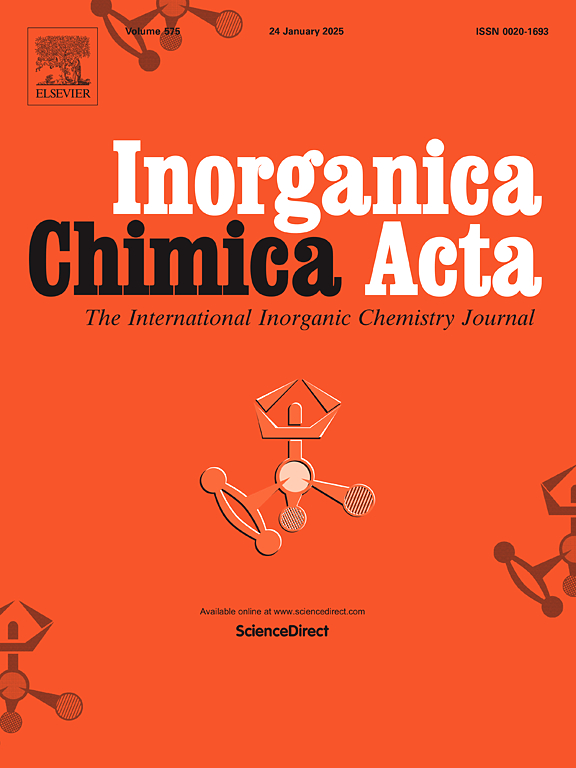Rare open zinc cluster of a novel multidentate Schiff base containing 1,2,3-triazole derivative: Stepwise synthesis, characterization, XRD, HSA, %Vbur, τ and CV studies
IF 2.7
3区 化学
Q2 CHEMISTRY, INORGANIC & NUCLEAR
引用次数: 0
Abstract
A novel multidentate Schiff base ligand, N'4,N'5-bis((E)-3,5-di-tert-butyl-2-hydroxybenzylidene)-1-(2-(2-((E)-3,5-di-tert-butyl-2-hydroxybenzylidene)hydrazinyl)-2-oxoethyl)-1H-1,2,3-triazole-4,5-dicarbohydrazide (5), was successfully synthesized via an acid-catalyzed condensation reaction. The process involved reacting 1-(2-hydrazineyl-2-oxoethyl)-1H-1,2,3-triazole-4,5-dicarbohydrazide (4) with three equivalents of the appropriate aldehyde under traditional Schiff base conditions. The synthetic route began with the preparation of 1,2,3-triazole tris-ester (3) from diethyl acetylenedicarboxylate (1) and ethyl azidoacetate (2), employing a highly efficient solvent-free reaction that yielded 96 %. Subsequent hydrazinolysis of the tris-ester afforded the tris-acid hydrazide (4) in 92 % yield.
NMR spectroscopy confirmed the structure of the hydrazide with distinct NH2 and NH protons resonating at 4.29–4.59 ppm and 8.79–9.39 ppm, respectively. Ligand 5, containing hydroxyl and nitrogen donor groups, was employed to synthesize binuclear zinc complexes with two independent zinc centers: Zn (Jos and Suja, 2023 (1)) displayed square pyramidal geometry, while Zn (Juyal et al., 2023 (2)) exhibited distorted octahedral geometry. The zinc complex crystallized in a triclinic system (P−1 space group) and formed a dimer stabilized by hydrogen bonding, with a packing arrangement that featured a major void stabilized by a 10-member hydrogen-bonded ring system.
Hirshfeld surface analysis (HSA) and cyclic voltammetry (CV) were performed to understand the complex's physical and electrochemical properties. Using ChimeraX software, the percent buried volume (%Vbur) was calculated, providing insights into steric interactions between the ligand and the zinc coordination sites. This analysis was essential for optimizing ligand design, minimizing steric hindrance around the metal centre. The findings of this study could aid in advancing Schiff base ligands and zinc complexes for materials science applications, though additional research is required. The results highlight the critical role of steric hindrance, NH, OH, NCH2, NCH, ethanol solvents, and acetic acid groups attached to the zinc metal in influencing the structural and reactive properties of metal-ligand complexes, offering valuable insights into their behaviour within chemical systems.

求助全文
约1分钟内获得全文
求助全文
来源期刊

Inorganica Chimica Acta
化学-无机化学与核化学
CiteScore
6.00
自引率
3.60%
发文量
440
审稿时长
35 days
期刊介绍:
Inorganica Chimica Acta is an established international forum for all aspects of advanced Inorganic Chemistry. Original papers of high scientific level and interest are published in the form of Articles and Reviews.
Topics covered include:
• chemistry of the main group elements and the d- and f-block metals, including the synthesis, characterization and reactivity of coordination, organometallic, biomimetic, supramolecular coordination compounds, including associated computational studies;
• synthesis, physico-chemical properties, applications of molecule-based nano-scaled clusters and nanomaterials designed using the principles of coordination chemistry, as well as coordination polymers (CPs), metal-organic frameworks (MOFs), metal-organic polyhedra (MPOs);
• reaction mechanisms and physico-chemical investigations computational studies of metalloenzymes and their models;
• applications of inorganic compounds, metallodrugs and molecule-based materials.
Papers composed primarily of structural reports will typically not be considered for publication.
 求助内容:
求助内容: 应助结果提醒方式:
应助结果提醒方式:


